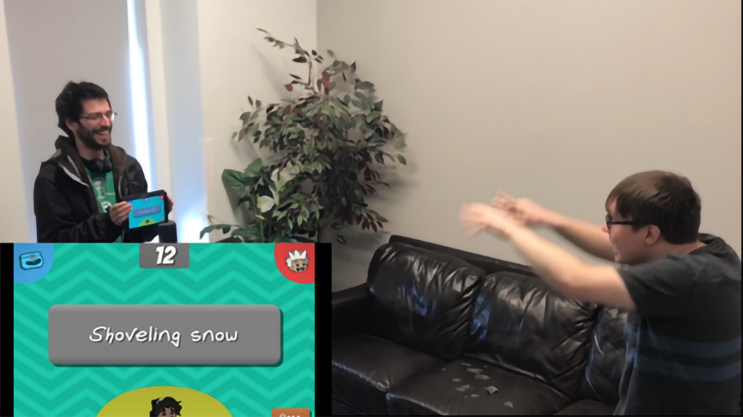Ontario Tech University
Games and Media Entertainment Research (GAMER) Lab
Where we learned about spatial sound generation and interactive audio, serious games for medical education, and visual and multimodal interactions.
Housed in the Software and Informatics Research Centre (SIRC Building) at Ontario Tech University (OTU) is the Games and Media Entertainment Research (GAMER) Lab. The Lab is an experimental games research unit for students at the graduate and under-graduate levels at OTU. The GAMER Lab provides opportunities to students to advance research projects related to various domains of games research: human-computer interaction, game science, gamification, interaction design, and user experience (UX), among others (“Laboratory for Games and Media Entertainment Research”).
For GAMER Lab, the advantage of being involved in this multi-institutional (and international) research network was the various IMMERSe-related events that brought together researchers and professionals physically. The IMMERSe network gave OTU the opportunity to interact with other researchers from various disciplines who share similar research interests, thereby enabling GAMER Lab researchers to learn and apply different research approaches. Dr. Bill Kapralos, Associate Professor and IMMERSe Theme leader has stated, “The mention of the relatively large IMMERSe network, always creates significant interest internationally. The impressive array of cross-disciplinary research within the IMMERSe network points to the support Canada offers to gaming research in general; this is seen as very positive and helps in significant ways in establishing collaborations abroad. It is impossible to put a dollar value to such connections” (IMMERSe Final Report).
Researchers at OTU were able to secure significant support from the OTU Faculty of Business and Information Technology for the ongoing maintenance of an IMMERSe-funded server at the GAMER Lab. The server supports a gamified educational social network for medical-based education and training developed by OTU, University of Toronto, Women’s College Hospital, The Hospital for Sick Children, and Memorial University. This network has been used in a variety of medical education courses and has been the source of inspiration for a large amount of scholarship. The success of this medical social and educational network has led to its expanded and adapted version targeted to (80+) adults developed in partnership with the Women’s College Hospital.
Thanks to the collaborative opportunities which came out of IMMERSe, OTU was able to secure additional financial support from both Canadian and international sources; such as Alexander von Humboldt Foundation, Germany, Shizuoka University, Japan, and the Canada-CARICOM Leadership Scholarship.
Bill Kapralos identifies that the fundamental purpose of the IMMERSe grant for OTU was to provide funding for student research in games. By examining the research outputs of OTU, we can begin to draw connections between different domains of study in games. Over the past 7 years of IMMERSe, OTU has contributed significant research into the fields of spatial sound generation and interactive audio, serious games for medical education, and visual and multimodal interactions.
Spatial Sound Generation and Interactive Audio
A significant portion of OTU’s IMMERSe research was focused within the domain of spatial sound generation and interactive audio, particularly the techniques surrounding generating sound in virtual environments and sonal mapping in interactive game worlds.
B. Cowan, a GAMER Lab PhD student, developed cutting-edge research toward the application of GPUs to spatial sound generation for games and virtual environments. His work attracted the interest of other researchers and industry and was published in Virtual Reality (2017 IF: 1.375) and the Journal of Graphics GPU and Game Tools.
Serious Games for Medical Education
GAMER Lab IMMERSe researchers made significant breakthroughs in the diverse application of digital technologies within the medical sector. This work began with development of the mSTREET serious games framework (with industry partner TubettiWorld Games) and culminated in the development of several serious games. Technologies developed, or currently under development, include a serious game for orthopedic surgery residents, a game to simulate surgical drilling, and a game for contraceptive education.
During this study, IMMERSe researchers also turned their attention to the application of Virtual Reality technologies in the development of serious games. One such project, under the direction of Bill Kapralos, involved the development of a VR framework related to anesthesia training. This work led to a summer 2018 internship at Sunnybrook for K. Wilcocks and ugrad student D. Chong, and an invited review article titled “Immersive realities in anesthesia” for top tier journal, Anesthesia (2017 IF: 4.741).
Visual and Audio Modality Interactions
Work in this domain included a series of human-based experiments that examined the effect of sound and music on visual fidelity perception and task performance. Unique to this work was the focus on audio-visual interactions within a stereoscopic 3D (S3D) viewing environment, a topic that Wallace Balaniuc, a Master of Science student funded through IMMERSe, focused his research on. Balaniuc now works as a Professor of Computer Science Engineering at Centennial College.
“Laboratory for Games and Media Entertainment Research.” Ontario Tech Business & IT, https://businessandit.uoit.ca/about/learning-environment/laboratory-for-games-and-media-entertainment-research.php Accessed 1 May, 2019.
Kapralos, Bill. “IMMERSe Final Report.”


